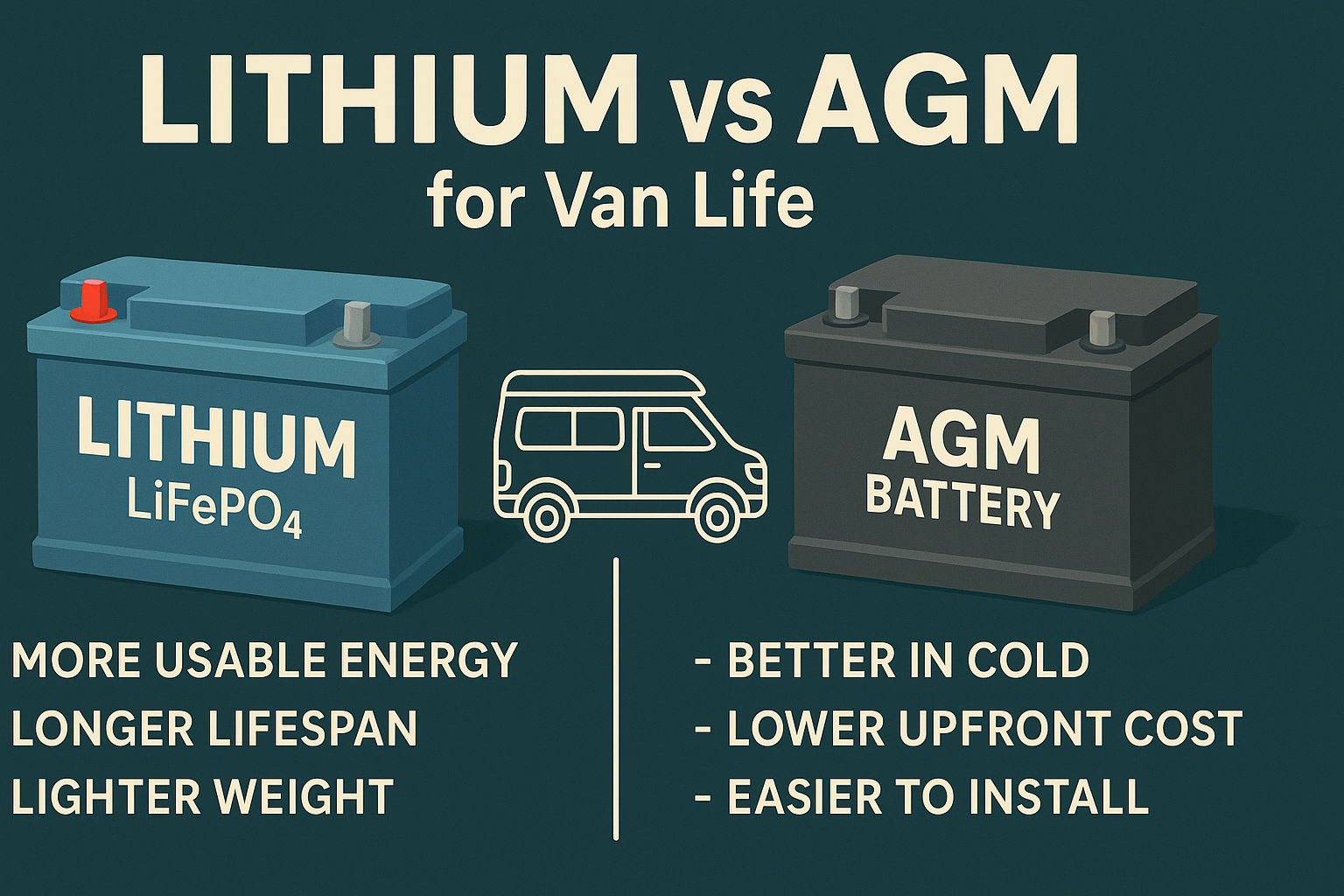Introduction
Van life energy systems depend heavily on the right battery. The choice between Lithium Iron Phosphate (LiFePO₄) and AGM batteries affects everything — how long you can stay off-grid, how quickly you recharge, and how much space and weight your rig can handle. A LiFePO₄ battery stores more usable energy, weighs less, and lasts longer. An AGM battery handles cold better, is easier to install, and costs less upfront.
People living in their vans full-time often pick lightweight LiFePO₄ batteries to power devices like 12V fridges, induction cooktops, and laptops. Others with tighter budgets or who camp in winter may lean toward sealed AGM batteries with lower initial investment. This comparison looks at real-world performance, battery chemistry, and charging behavior to help you choose the best fit.
Key Takeaways
- LiFePO₄ batteries provide more usable energy, longer cycle life, and lighter weight compared to AGM.
- AGM batteries perform better in cold temperatures and have lower upfront costs.
- Lithium systems charge faster, with higher efficiency, making them ideal for solar-heavy van life setups.
- AGM batteries require more maintenance and are less suited for long-term deep cycling.
- Lithium batteries offer a lower total cost of ownership, especially for full-time van life and off-grid use.
- Proper system design and compatible charging equipment are essential for both chemistries.
- AGM is a good fit for budget-conscious or we
Battery Chemistry Overview
LiFePO₄ Internal Design
A LiFePO₄ battery uses lithium iron phosphate as the cathode material and a graphite anode, providing a stable voltage curve and long cycle life. Inside, prismatic or cylindrical cells work with a built-in Battery Management System (BMS) to regulate voltage, prevent overcharge, and control temperature.
AGM Internal Structure
AGM batteries use lead dioxide and sponge lead plates, separated by fiberglass mats soaked in electrolyte. This design allows for sealed operation and zero off-gassing. But unlike Lithium, AGM batteries suffer from voltage drop under load and require longer charge times due to their absorption phase.
| Feature | LiFePO₄ | AGM |
|---|---|---|
| Nominal Voltage | 12.8V | 12.0V |
| Depth of Discharge | 80–90% | 50% |
| Cycle Life | 3,000–6,000+ | 300–500 |
| Internal Resistance | Very Low | Moderate |
| Charging Speed | Fast (1C rates possible) | Slower due to absorption phase |
| Self-Discharge | <3% per month | ~15% per month |
| Operating Temp Range | 0°C to 60°C (charging limits) | -20°C to 50°C |
| Maintenance | None | Low (must maintain full charge) |
Usable Capacity & Depth of Discharge (DoD)
Usable capacity is the amount of stored energy a battery can deliver before needing to be recharged. This depends on the Depth of Discharge (DoD) — how much of the battery’s capacity is actually usable without causing damage.
A LiFePO₄ battery offers 80% to 90% usable capacity, while an AGM battery should only be discharged to 50%. In van builds with limited space, this difference adds up.
| Battery Type | Rated Capacity | Usable Capacity | % Usable |
|---|---|---|---|
| LiFePO₄ | 100Ah | 80–90Ah | 80–90% |
| AGM | 100Ah | 50Ah | 50% |
Weight, Volume & Space Considerations
LiFePO₄ batteries outperform AGM batteries in both weight and volume. A 100Ah lithium battery typically weighs 25 to 30 pounds, while a 100Ah AGM battery weighs 60 to 70 pounds.
| Battery Type | Capacity (Ah) | Weight (lbs) | Volume (approx) |
|---|---|---|---|
| LiFePO₄ | 100Ah | 27 lbs | Small footprint |
| AGM | 100Ah | 65 lbs | Larger footprint |
Charge Efficiency & Speed
LiFePO₄ batteries charge more efficiently and faster than AGM. Lithium skips the long absorption phase that slows down AGM charging.
| Battery Type | Max Charge Rate | Typical Full Charge Time | Charge Efficiency |
|---|---|---|---|
| LiFePO₄ | 1C (100A for 100Ah) | 2–3 hours | 95–99% |
| AGM | ~0.3C (30A for 100Ah) | 6–8 hours | ~85% |
Cycle Life & Long-Term Value
LiFePO₄ batteries last 6 to 10 times longer than AGM batteries, making them a smarter long-term investment.
| Battery Type | Cycle Life | Estimated Lifespan (Daily Use) | Cost per Cycle (Est.) |
|---|---|---|---|
| LiFePO₄ | 3,000–6,000+ | 8–12 years | Low |
| AGM | 300–500 | 1–2 years | High |
Low Temperature Performance
AGM batteries tolerate freezing better than Lithium. LiFePO₄ batteries cannot be charged below 32°F without damage.
| Battery Type | Safe Charging Temp Range | Cold Weather Solution | Cold Storage Tolerance |
|---|---|---|---|
| LiFePO₄ | 32°F to 113°F (0–45°C) | Heated LiFePO₄ units | Down to -4°F (-20°C) |
| AGM | -4°F to 122°F (-20–50°C) | None needed | Same as charging range |
Charging Methods & Compatibility
AGM batteries work with most traditional chargers. LiFePO₄ batteries require lithium-compatible gear, especially with DC-DC chargers and MPPT controllers.
| Charging Source | AGM Compatibility | LiFePO₄ Compatibility |
|---|---|---|
| Solar Panels | Yes (PWM/MPPT) | Yes (MPPT preferred) |
| Alternator | Direct compatible | Needs DC-DC charger |
| Shore Power | Most smart chargers work | Needs lithium profile charger |
Safety, Maintenance & Monitoring
Lithium batteries come with built-in safety protections, while AGM batteries depend on proper system design.
| Feature | LiFePO₄ | AGM |
|---|---|---|
| Built-in Protection | Yes (BMS) | No (external only) |
| Maintenance | None | Must stay fully charged |
| Monitoring Accuracy | High (smart BMS / Bluetooth) | Medium (voltage-based) |
| Risk of Overcharging | BMS prevents it | Needs correct charger settings |
| Risk of Deep Discharge | BMS cut-off | Capacity loss likely |
Budget & Cost Breakdown
While AGM is cheaper up front, Lithium is more cost-effective long-term.
| Cost Factor | LiFePO₄ System (200Ah usable) | AGM System (200Ah usable) |
|---|---|---|
| Initial Battery Cost | $1,200 | $600 (for 400Ah AGM) |
| Replacement Cycles | 0 | 3–4 |
| Charger / BMS Cost | $300 | $100 |
| Total 10-Year Cost | ~$1,500 | ~$1,800–$2,400 |
Maintenance & Reliability
LiFePO₄ batteries offer reliable performance with no maintenance. AGM requires charge maintenance to avoid sulfation.
| Issue | LiFePO₄ | AGM |
|---|---|---|
| Self-Discharge in Storage | <3% per month | Up to 15% per month |
| Deep Discharge Damage | BMS cutoff protection | High risk without LVD |
| Performance After Sitting | Consistent | May degrade if undercharged |
| Charging Consistency | Holds voltage throughout charge | Voltage drops under load |
| Reliability in Remote Areas | High (if kept above freezing) | Medium (more capacity needed) |
Best Use Cases: When to Choose Which
AGM Makes Sense When…
- Budget is limited
- Van is used part-time or seasonally
- You travel in cold climates
- Simpler systems are preferred
LiFePO₄ Is Ideal When…
- You live full-time in your van
- You need faster solar recharge
- Weight and space matter
- You want a low-maintenance system
| Use Case | Recommended Battery |
|---|---|
| Weekend Trips | AGM |
| Full-Time Van Living | LiFePO₄ |
| Cold Climate Winter Camping | AGM (or heated LFP) |
| Lightweight Minimalist Build | LiFePO₄ |
| Short-Term Budget Build | AGM |
| Solar-Only Charging System | LiFePO₄ |
| High-Power Appliance Use | LiFePO₄ |
Installation Considerations
| Component | LiFePO₄ Recommendation | AGM Recommendation |
|---|---|---|
| Under-seat install | Ideal | Possible (ventilation needed) |
| Exterior box mount | Only with insulated enclosure | Acceptable |
| Inverter proximity | Close (low voltage drop) | Same |
| Vertical mounting | OK if allowed by battery design | Horizontal preferred |
Product Comparisons & Reviews
Popular LiFePO₄ Battery Brands
| Brand | Capacity Options | Features | Approx. Cost | Warranty |
|---|---|---|---|---|
| Battle Born | 100Ah, 270Ah | Internal BMS, USA-made | $$$ | 10 years |
| Renogy | 100Ah, 200Ah | Smart BMS, Bluetooth | $$ | 5 years |
| Dakota Lithium | 100Ah, 135Ah | Lightweight, compact | $$$ | 11 years |
| Zooms | 100Ah, 200Ah | Budget-friendly | $ | 5 years |
| Victron Energy | 160Ah, 200Ah | High-end, deep integration | $$$$ | 3–5 years |
Popular AGM Battery Brands
| Brand | Capacity Options | Features | Approx. Cost | Warranty |
|---|---|---|---|---|
| VMAXTANKS | 100Ah–300Ah | Long shelf life | $$ | 1–2 years |
| Universal Power | 100Ah–200Ah | Compact case | $ | 1 year |
| Trojan | 100Ah–225Ah | Heavy duty | $$$ | 2–3 years |
| Lifeline | 100Ah–220Ah | Military-grade | $$$$ | 5 years |
| Renogy AGM | 100Ah, 200Ah | Budget-friendly | $$ | 1–2 years |
System Scalability
| Scalability Factor | LiFePO₄ | AGM |
|---|---|---|
| Parallel Expansion | Easy (matched batteries) | Risk of imbalance |
| Series Expansion | Supported (with BMS sync) | Requires identical specs |
| Load Handling | High loads supported | Limited by voltage drop |
| Upgrade Flexibility | Modular, plug-and-play | Requires complete bank replacement |
Total Cost of Ownership Over Time
| Item | AGM (400Ah for 200Ah usable) | LiFePO₄ (200Ah usable) |
|---|---|---|
| Initial Battery Purchase | $600–$700 | $1,200–$1,500 |
| Replacements (3x) | $1,800–$2,100 | $0 |
| Extra Gear (DC-DC, etc.) | $100 | $300–$500 |
| Total Estimated Cost | $2,500–$2,900 | $1,500–$2,000 |
Choosing the Right Size
| Appliance | Power (W) | Hours Used | Daily Consumption (Wh) |
|---|---|---|---|
| 12V Fridge | 60W | 24 hrs | 720Wh |
| Lights (LED) | 20W | 4 hrs | 80Wh |
| Laptop Charging | 65W | 2 hrs | 130Wh |
| Fan / Ventilation | 20W | 6 hrs | 120Wh |
| Phone Charging | 15W | 2 hrs | 30Wh |
| Total | 1,080Wh/day |
| Daily Need (Ah) | AGM Required (Ah) | LiFePO₄ Required (Ah) |
|---|---|---|
| 90Ah | 180Ah | 100–120Ah |
| 150Ah | 300Ah | 180–200Ah |
| 200Ah | 400Ah | 240–250Ah |
FAQ Section
Can I mix AGM and Lithium batteries in the same system?
Best Answer: No. Mixing different chemistries can lead to unsafe voltage mismatches and charging issues. They require different charging profiles and have different internal resistances.
Do Lithium batteries need ventilation?
Best Answer: No. LiFePO₄ batteries are sealed and do not off-gas during normal operation. AGM batteries are also sealed, but may require minimal airflow if overcharged.
Can I charge a Lithium battery with my alternator?
Best Answer: Yes, but only through a DC-DC charger. Direct alternator charging may damage the battery or your alternator due to the current draw and voltage mismatch.
What size DC-DC charger do I need for Lithium?
Best Answer: Use a charger rated at 30A to 60A, depending on your battery bank size. Check the manufacturer’s charge rate recommendations (usually up to 1C).
What happens if I charge Lithium below freezing?
Best Answer: Charging below 32°F (0°C) without a heating mechanism can permanently damage the cells. Use self-heated batteries or insulate your battery area.
Top Reference URLs
- “AGM Vs. Lithium Batteries: Which Are Better For Solar RV & Camper Van Battery Banks” — RELiON RELiON
- “AGM vs Lithium Batteries for Van Life” — Papa Go Vans blog Papago Vans
- “What Is the Best Battery for a Campervan? AGM vs. Lithium” — Muse Outdoors Muse & Co. Outdoors
- “AGM Batteries vs. Lithium Batteries” — Boho Camper Vans blog boho.life


